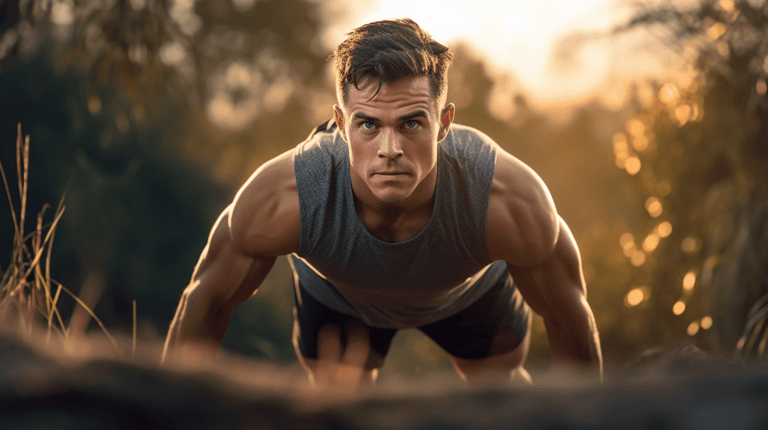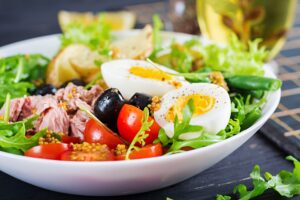Are you tired of spending hours at the gym, only to see minimal results? Do you want to burn fat and tone your muscles, but not at the expense of your lean mass?
Well, you’re in luck! HIIT, or High-Intensity Interval Training, is here to revolutionize your fitness routine and help you achieve your goals. With HIIT, you can prioritize fat loss while preserving your lean mass, giving you the best of both worlds.
So, what exactly is HIIT? It’s a workout method that involves short bursts of intense exercise followed by periods of rest or low-intensity activity. This alternating pattern not only keeps your heart rate up but also challenges your body in a way that traditional cardio alone can’t.
By incorporating HIIT into your fitness routine, you can maximize fat burning while maintaining and even increasing your muscle mass. With HIIT, your body becomes a fat-burning machine. The intense bursts of exercise push your body to its limits, causing it to tap into its fat stores for fuel.
This means that even after your workout is over, your body continues to burn fat for hours, leading to increased calorie burn and weight loss. Plus, HIIT helps to preserve your lean muscle mass by stimulating muscle growth and preventing muscle breakdown.
So, not only will you be shedding those unwanted pounds, but you’ll also be sculpting and toning your muscles for a lean, defined physique.
Say goodbye to endless hours on the treadmill and hello to a more efficient and effective way of working out. Get ready to burn fat, not muscle, with HIIT!
Key Takeaways
- Incorporate whole grains, sweet potatoes, and quinoa into your diet for optimal recovery.
- Aim for a moderate calorie deficit of around 500 calories per day to lose fat while preserving muscle mass.
- Stay hydrated by drinking at least 8 glasses of water per day.
- Replenish minerals lost through sweat by adding electrolytes to your water.
Understanding HIIT (High-Intensity Interval Training)
HIIT, or High-Intensity Interval Training, is a popular workout method that alternates between intense bursts of exercise and short recovery periods. It’s a great way to burn fat and lose weight while preserving lean muscle mass.
In fact, studies have shown that HIIT can burn 25-30% more calories than other forms of exercise. So if you’re looking to shed some pounds and get in shape, HIIT is definitely worth considering.
The beauty of HIIT is that it can be tailored to fit your fitness level and goals. You can choose exercises that target specific areas of your body or focus on overall fat burning. Plus, the intensity of the workouts can be adjusted to match your capabilities. You can benefit from HIIT, whether you’re a beginner or a seasoned athlete.
Not only does HIIT help you burn fat, but it also helps you build endurance and improve cardiovascular health. By pushing your body to its limits during the intense bursts of exercise, you’re increasing your heart rate and challenging your cardiovascular system. This can lead to improved cardiovascular efficiency and overall better health.
The Science Behind Fat Loss and Muscle Preservation
Understanding the science behind losing body fat and maintaining muscle mass is essential for achieving your fitness goals. When it comes to burning fat, HIIT (High-Intensity Interval Training) is a highly effective method that prioritizes fat loss while preserving lean mass. How does it work? Let’s dive into the science.
- HIIT increases your metabolic rate: High-intensity exercises like sprints or burpees push your body to its limits, causing a significant increase in your metabolic rate. This means that even after your workout, your body continues to burn calories at a higher rate, leading to greater fat loss over time.
- HIIT triggers the afterburn effect: The intense nature of HIIT workouts creates an oxygen debt in your body. To repay this debt, your body continues to consume oxygen and burn calories even after you’ve finished exercising. This afterburn effect can last for hours, further contributing to fat loss.
- HIIT preserves muscle mass: Unlike traditional steady-state cardio exercises, HIIT workouts stimulate muscle growth and maintenance. The short bursts of intense activity signal your body to retain muscle mass while shedding fat. This is crucial because preserving lean muscle mass is aesthetically pleasing and plays a vital role in maintaining a healthy metabolism.
Benefits of HIIT for Fat Burning
With its intense and dynamic workouts, HIIT becomes a fiery furnace melting away excess pounds, leaving behind only sculpted strength. When you engage in high-intensity interval training, your body enters a state of metabolic overdrive. This means that your metabolism is revved up and working at full speed, even hours after your workout.
As a result, your body becomes a fat-burning machine, torching calories and melting away stubborn body fat. Unlike other forms of exercise that primarily burn carbohydrates for fuel, HIIT targets fat stores as its primary energy source, making it incredibly effective for fat loss.
Not only does HIIT help you burn fat, but it also helps you preserve lean muscle mass. Traditional cardio workouts, such as steady-state running or cycling, can lead to muscle loss along with fat loss. However, HIIT workouts are designed to preserve lean muscle mass while targeting fat stores.
Designing an Effective HIIT Workout
First and foremost, you need to determine your fitness goals. Are you looking to burn fat, increase endurance, or improve overall fitness? Once you have a clear goal in mind, you can tailor your HIIT workout to suit your needs.
Next, consider the exercises you will include in your routine. HIIT workouts typically consist of short bursts of intense exercise followed by periods of rest or lower intensity exercise. Choose exercises that target multiple muscle groups and elevate your heart rate. This could include exercises like burpees, mountain climbers, or kettlebell swings. By incorporating a variety of exercises, you’ll keep your body challenged and prevent boredom.
In addition to exercise selection, it’s important to consider the duration and intensity of your HIIT workout. HIIT sessions are typically shorter in duration, ranging from 10 to 30 minutes. However, the intensity should be high enough to push your limits and elevate your heart rate. This will help maximize fat burning and improve cardiovascular fitness. Remember to listen to your body and gradually increase the intensity as you become fitter and more comfortable with the exercises.
Lastly, don’t forget to include proper warm-up and cool-down periods in your HIIT workout. A warm-up prepares your body for the intense exercise to come, while a cool-down helps your body recover and prevents muscle soreness. Incorporate dynamic stretches and light cardio exercises into your warm-up, and finish your workout with static stretches to improve flexibility.
How Does HIIT Training Preserve Lean Muscle Mass While Boosting Metabolism?
HIIT, or high-intensity interval training, is known for its ability to improve the metabolic impacts of HIIT. This form of exercise helps preserve lean muscle mass while boosting metabolism, leading to increased calorie burning even after the workout is over. This makes HIIT a popular choice for those looking to maintain muscle while trying to shed fat.
Nutrition Tips for Maximizing Fat Loss and Muscle Preservation
Maximize your fat loss and preserve muscle by incorporating these nutrition tips. Regarding HIIT workouts, nutrition plays a crucial role in achieving your desired results. You can optimize fat burning while preserving lean muscle mass by fueling your body with the right nutrients. Here are some key nutrition tips to help you maximize your fat loss and muscle preservation:
| Nutrients to Focus On | Benefits | Food Sources |
|---|---|---|
| Protein | Helps repair and build muscle tissue | Chicken, fish, eggs, tofu |
| Healthy Fats | Provides energy and supports hormone production | Avocado, nuts, olive oil |
| Complex Carbohydrates | Fuels your workouts and aids in recovery | Whole grains, sweet potatoes, quinoa |
In addition to focusing on these nutrients, paying attention to your overall calorie intake is important. While you may be tempted to drastically reduce your calories to accelerate fat loss, this can actually be counterproductive. Your body needs sufficient energy to fuel your workouts and support muscle growth. Aim for a moderate calorie deficit of around 500 calories daily to ensure steady fat loss while preserving muscle mass.
Furthermore, hydration is key for both fat loss and muscle preservation. Drinking an adequate amount of water not only keeps you hydrated during your workouts but also aids in digestion and nutrient absorption. Aim to drink at least 8 glasses of water per day, and consider adding electrolytes to your water to replenish minerals lost through sweat.
Frequently Asked Questions
How long should a HIIT workout last?
A HIIT workout should typically last between 20 to 30 minutes. This duration allows you to maximize fat burning while preserving muscle mass. Remember, it’s not about the length of the workout, but the intensity you bring to it.
Can people of all fitness levels do HIIT?
Yes, HIIT can be done by people of all fitness levels. It’s a versatile workout that can be modified to suit your abilities and goals. Get ready to challenge yourself and see amazing results!
Are there any specific exercises that are better for fat loss during HIIT?
Yes, there are specific exercises that are better for fat loss during HIIT. Exercises like burpees, mountain climbers, and jump squats engage multiple muscle groups and increase calorie burn, helping you shed fat faster.
How often should HIIT workouts be done for optimal results?
To achieve optimal results, you should aim to do HIIT workouts 3-5 times a week. Research shows that this frequency can boost your metabolism and maximize fat loss, helping you reach your fitness goals faster. Keep pushing yourself!
Is it necessary to track macros and calories while following a HIIT program?
No, it’s not necessary to track macros and calories while following a HIIT program. Instead, focus on fueling your body with nutritious foods and listening to its signals. Trust that your body knows what it needs to thrive.

















